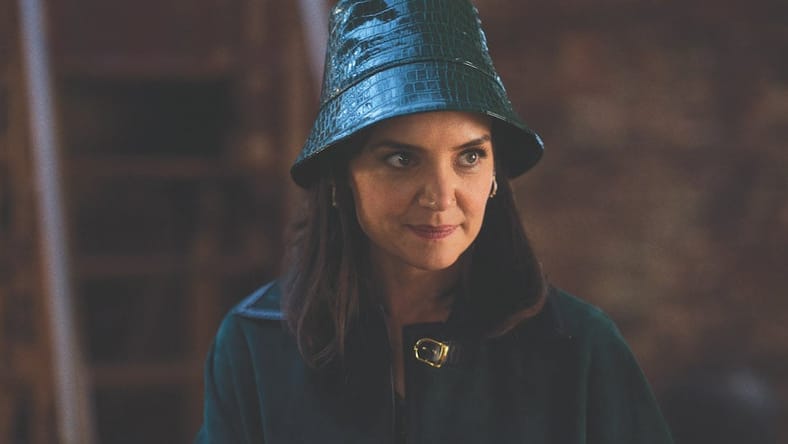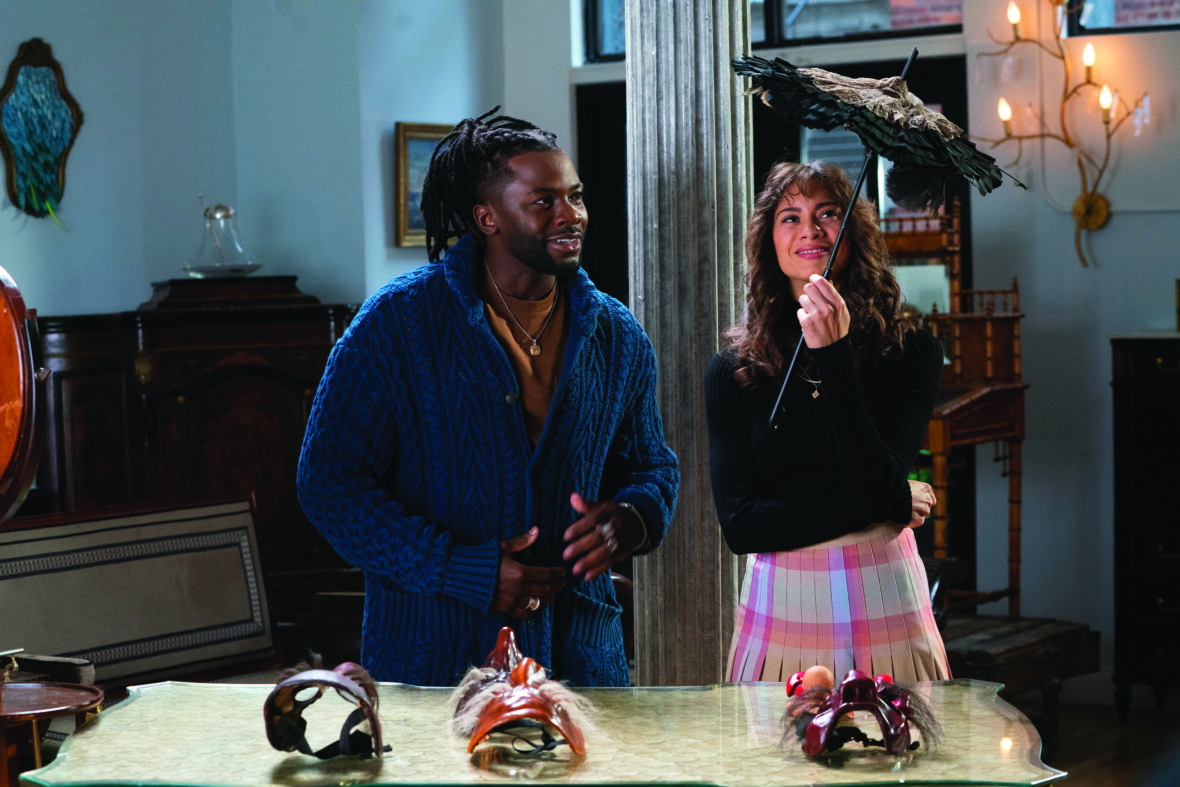
Katie Holmes’ roles in The Ice Storm and Dawson’s Creek made her a star almost as soon as she started acting in the late ‘90s. But on-camera, she could only influence a project through her performances.
Watching the directors who hired her — from Ang Lee on 1997’s The Ice Storm to Curtis Hanson in 2000’s Wonder Boys to Christopher Nolan in 2005’s Batman Begins — the Ohio-born star saw a way to have a greater impact on her films.
She broke into directing in 2015 with a 30 for 30 short about Olympic gymnast Nadia Comaneci, “Eternal Princess,” then made her feature debut the next year with All We Had, in which she also starred. But she kept learning from her directors, including Steven Soderbergh, for whom she starred in 2017’s Logan Lucky.
At 44, she’s reintroduced herself not only as an actor, but also as a writer and director with two feature credits in the last two years. Her new film, Rare Objects, is about a young woman named Benita (Julia Mayorga), recovering from PTSD after a sexual assault, who takes a job at a Manhattan boutique that sells rare artifacts to wealthy clientele.
The cast also includes Alan Cumming as the shop’s owner and Holmes as a friend from treatment who re-enters Benita’s life as an affluent patron of the shop. Rare Objects is adapted from a 2016 novel by Kathleen Tessaro, but Holmes and her co-writer, Phaedon Papadopoulos, shifted the setting from Boston in the Great Depression to New York City in the present day.
We spoke with Holmes during some rare downtime as she starred in the off-Broadway production The Wanderers.
Daniel Joyaux: Do you remember any specific moment where you first thought you’d like to direct your own film?
Katie Holmes: I remember meeting with a friend of mine, the producer Jane Rosenthal, about 10 or 11 years ago, and she brought it up to me. It’s something I had thought about here and there, having a lot of experience being led by some really great directors and having taken a lot of wisdom from them.
I thought it sounded overwhelming, so I started small and did a 30 for 30 short. And just being behind the camera and in the editing room, and really shaping and crafting a piece of work, was something I really enjoyed. So that led me to my first feature.
I really enjoyed the process of working with the actors and seeing what they brought to the characters that I had missed. That’s the beauty of actors — they read something and they interpret it in their own way, and they bring their whole self to it. It’s so exciting because then the scenes become something far deeper than you had imagined.
And it was so new to me to work with a cinematographer and craft a story visually. I started to get hooked on the excitement of finding new ways to get ideas across.
Daniel Joyaux: What was the more difficult hurdle: Believing in yourself that you could direct a movie, or getting others to believe that you could do it?
Katie Holmes: I felt very supported. My crew knew it was my first time. They taught me a lot, and it was definitely an experience where you’re learning every day. You’re believing in yourself enough to learn when you got things right, or also when, “Oops, that didn’t work, and I’ll learn for the next one.”
Every project I’m on, whether acting or directing, you kind of start with, “How is this ever gonna work, how am I ever gonna do this.” And then you slowly start to familiarize yourself with the material and get to know it. You have to honor the work that you’re doing and try your best to contribute.
Daniel Joyaux: You’ve worked with so many amazing directors. Does anyone stand out in terms of what you learned?
Katie Holmes: I think it’s pieces from all of them. I remember Curtis was very nurturing to all of us, and he understood that I was quite overwhelmed with that cast. He was very generous in making me feel comfortable in that environment. That meant so much to me, and I try to emulate that with actors. If I feel they’re nervous about something or they don’t feel comfortable, I really take the time to get them to a place where they feel confident.
Steven Soderbergh is so good with story and he’s so prepared on set. He just knows how the puzzle fits together before you start shooting. His efficiency is very inspiring to me and in prep I really try to minimize safety shots. That can be difficult at first because when you’re in the editing room you want to have extra things. So it’s really about being strong in your vision, which I learned from him.
Daniel Joyaux: How did you first encounter the novel Rare Objects and what made you decide to adapt it?
Katie Holmes: I read it around 2016, and what drew me to it were the two female characters — their friendship, the hardships that they were going through, and yet they maintained that friendship. I felt like it reflected the best of female friendships, and it wasn’t afraid to reveal aspects of these characters that were difficult and scary and not fair.
That was something I wanted to bring to the screen. I also like the world of this antique store, and the metaphor of the value of these old things and the value of history.
Daniel Joyaux: What was your process of collaborating with your co-writer, Phaedon Papadopoulos?
Katie Holmes: We met through Barry Welsh, who was a producer on All We Had. Our process was great; we spent a long time adapting it as a period piece, and basically he would come to New York and we’d go through ideas — writing them in, tossing them out, challenging each other. He’s a wonderful collaborator. We’d also walk around the city, immersing ourselves in the neighborhoods.
Also Read: Owen Wilson’s Road Goes on Forever: In Paint, He’s an Artist Confronting Middle Age (Cover Story)
Daniel Joyaux: The first film you wrote, 2022’s Alone Together, was an original screenplay, and this one is adapted. Which one was more difficult, or went through more drafts?
Katie Holmes: Definitely Rare Objects was more drafts. When you’re adapting, you first want to do everything the book does. Then you feel like, “Okay, that’s too much, can’t fit it all in. So what are the things from the book that really stand out? Okay, that’s still too much.”

They’re two very different animals. It’s taking pieces and then crafting something that is three acts. At a certain point you have to say it’s okay to change things, and letting go of things is also its own process. You tell yourself you have to do certain things, but sometimes you don’t. It’s that process of really figuring out what the essence is that you originally wanted, and then how do you recreate that in a screenplay?
Katie Holmes on Directing Fellow Actors
Daniel Joyaux: How did you find your lead actress, Julia Mayorga?
Katie Holmes: This was the second time that I worked with Avy Kaufman, my casting director. She cast me in The Ice Storm, which was my first-ever job. So I love working with her, and finding Julia was really exciting. She hasn’t done that much, but she understood who this person is.
Daniel Joyaux: Alan Cumming brings such a soothing gentleness to his role. Is that how the character was written, or something you innovated with him?
Katie Holmes: That was really Alan’s interpretation of the character. He brought that gentleness, which was so necessary, because Benita is still wounded, but she’s putting herself out there. I really believe in that — there are moments where there’s kindness coming from someone you didn’t expect. That’s what we really wanted that relationship to be, and I think it’s also very reflective of what New York can be.
Daniel Joyaux: What was your biggest challenge in post production?
Katie Holmes: The flashbacks were a big challenge. We had a lot of different versions of how long to be in the flashbacks and when to come back. Post is difficult because you’ve worked really hard, you’ve shot all this stuff, and you have this vision, and then you have to put it all together. It’s a puzzle, and it’s almost a whole new story. Different parts come out to you, and you think, “Oh, maybe the story is this.” There are so many different things you can do.
But I feel very confident in the film and in my vision for it. What I wanted for it was a film about women, friendship, hope, healing, and New York City, and I feel like that was fully realized. So I’m proud, and I feel confident that people will connect with it. Hopefully.
Main image: Katie Holmes playing Diana Van der Laar in her film Rare Objects. Courtesy of IFC Films.

